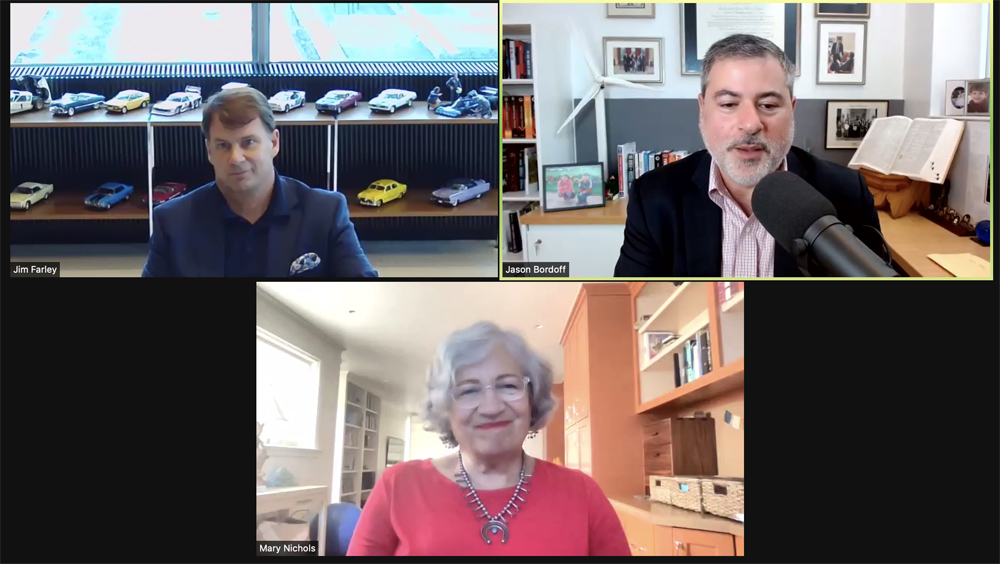
The growing adoption of electric vehicles is changing how consumers look at transportation and forcing automakers and policymakers to think about a multitude of disciplines beyond automotive design, from mining and recycling to emissions and urban planning.
In persuading people to buy an EV, product execution may play a bigger role than whether it’s an electric car or not, so the responsibility is on manufacturers “to surprise customers with the execution,” Ford Motor Company CEO Jim Farley said Thursday. “That seems to be driving the demand, not just electrification.”
Farley made his remarks during a webinar hosted by Columbia University’s Center on Global Energy Policy, appearing with the CGEP’s Director Jason Bordoff and distinguished visiting fellow Mary Nichols, former chairwoman of the California Air Resources Board.
Tipping Point
The moment when the EV market is going to take off is finally here it seems, Farley said.
“The Mustang Mach-E is sold out in the U.S., Europe and China — not just a little sold out, like a year sold out,” Farley said. “Enthusiasm for the product is very high.”
The F-150 is probably the model he watched the closest, he said, being America’s bestselling vehicle overall for 40 years.
“We have 150,000 orders, so it’s actually quite overwhelming right now to see the adoption,” Farley said. “Our market share is 50% of the light duty commercial vehicles in the U.S., so if you’re doing work with a vehicle in the U.S., 50% of them are a Ford. And we are the first one to have an electric van and an electric pickup, and we’re number one in both segments.”
Bi-directional charging has been of interest to Nichols since the Fukushima disaster, when the Japanese used their EVs to keep factories — and their own homes — powered, she said.

Ford designed its vehicles to be power stations, and the company saw a big increase in demand for that functionality after the blackouts in Texas last winter, Farley said.
“Right now, basically, the vehicle will be able to power your home,” Farley said. “Selling electrons back to the grid could be a big solution to our energy issues and the grid issues for peak demand … but we haven’t worked that out. The solar industry has done it, but it was a really painful process about how to sell electrons back to the grid from personal solar systems. We are just starting that discussion with the Edison Institute and some forward-leaning utilities, like the ones in California.”
States regulate the utility industry, “maybe not as much as some of my fellow regulators would like, but, still, [utilities] don’t make a move without knowing that they’re going to be able to get cost recovery from it, so it doesn’t feel like [net metering for EVs] is at the top of the agenda where it probably needs to be at this point,” Nichols said.
Global Issues
Most global carmakers are investing heavily in the transition to EV production, but some are worried that the switch could hit workers as well as their bottom line.
Trade journal Inside EVs in mid-September reported Toyota CEO Akio Toyoda saying “that going all-EV could cost Japan 5.5 million jobs and 8 million units of lost vehicle output by 2030.”
General Motors announced in June that it will invest $35 billion in EVs and automated driving systems through 2025, and in July, CNBC reported that Stellantis — the merged Fiat Chrysler/PSA Groupe — plans to invest at least $35.5 billion in EVs and supporting technologies over the same time frame.
Farley and Nichols serve as co-chairs of the Commission on the Future of Mobility, which is trying to grapple with some of these questions and includes representatives from groups and businesses interested in mobility.
“We still are having a hard time, even as a group of people with experience and some claims to leadership, framing some of the really big airy questions,” Nichols said. Topics include “the whole freight sector, which also has a big stake — but that puts you in the business of urban planning.”
Automakers currently make money on the after-sales business, but that will go away as EVs require much less maintenance than internal combustion vehicles, Farley said.
“I think the electric vehicle is going to really challenge that assumption that the value is in the vehicle itself, and maybe the after-sales is not a profit endeavor like it has been for us,” Farley said.
Workforce “risk is something I think about every day with this transition,” Nichols said.
The American industry needs creative solutions to bring the supply chain back to the U.S., from batteries to silicon to mining, Farley said. “No one wants a mine in their neighborhood, but we have to mine or else we’re going to be shipping these materials halfway around the world.”
Today in Europe, 90% of vans are diesel and 20% of passenger cars have a plug, so the transition is going a lot slower for commercial vehicles, Farley said. “Commercial vehicles in China are really different, with three-wheelers and that kind of thing. They are actually going to EVs very quickly in China, but I’d say in general commercial vehicles are 10 years behind passenger vehicles.”
Asked what he wants from the government, Farley said, “Customers are really smart; they do the math, so we have to continue to get support from government leaders to put their foot on the scale of the economics and make this work for more customers.”
“That’s exactly what we’ve been hoping for in the state of California,” Nichols said. “We … try to make the case and educate people about electric vehicles and learned that, first of all, the people weren’t aware that they even existed, or that there were any vehicles out there that would meet their particular needs, and I think we’ve finally begun to turn that around.”


